Among the nature and hilltop villages of Italy’s green heartland, Amy McPherson discovers that travelling slowly on foot means seeing and experiencing more…
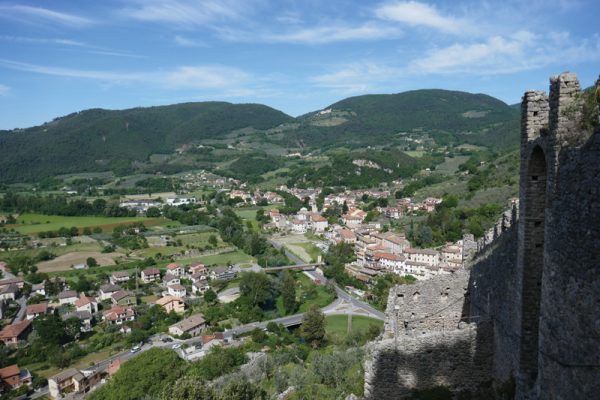
There is something very precious about the steps we take, knowing that thousands have taken the same steps before us, hundreds of years ago.
Their mission was to follow a spiritual path, laid before them by the saints whose souls lead them perhaps towards God, or more inwards, towards themselves.
Not that I am particularly religious. Yet it was the act of pilgrimage of the faithful, whose heart set up the physical task of walking thousands of miles towards enlightenment, that began what we call tourism today. We just seem to do everything much faster now.
Following the footsteps of the faithful, I embarked on a six-day walking trip organised by On Foot Holidays through the hills of Umbria, in search of the spirit of discovery – slowly.
Discovering Spoleto
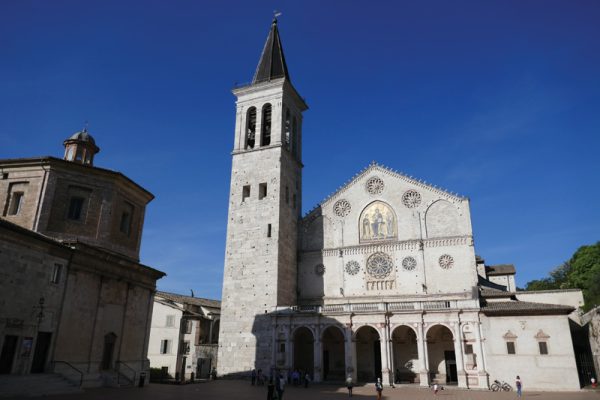
While it isn’t on the mainstream tourist trail, it is hard to ignore the fortified city of Spoleto.
Poised around a gentle valley surrounded by southeastern Umbrian hills, Spoleto’s past of being the capital of a Lombard Duchy and as a Papal State gave the city its wealth and sophistication.
Among the city’s ancient arches, churches and a Roman theatre, I found myself browsing through trendy boutiques and a cluster of osterias and trattorias.
Considering Spoleto’s ancient origins, the city is surprisingly up-to-date, including a modern cable car that helps with the steep hills.
This acceptance of mixing timelines and cultures is best illustrated at the city’s most important cultural event, the Festival of Two Worlds, founded by composer Gian Carlo Menotti in 1958 in order to celebrate the clash of European and American cultures in the modern times.
My quick turn about Spoleto only scratched at the surface of the city’s many delights, but I couldn’t linger here long as I had a walk to get on.
Befitting an itinerary that roughly follows two official long distance pilgrimage trails – the Via di San Francesco and the Via Francigena – I start off from the square of the 12th-century Romanesque Duomo, leaving the city’s prominent landmarks of the castle and the Roman bridge, il Ponte delle Torre, heading off in the direction of Rome.
Like Icing on Cupcakes
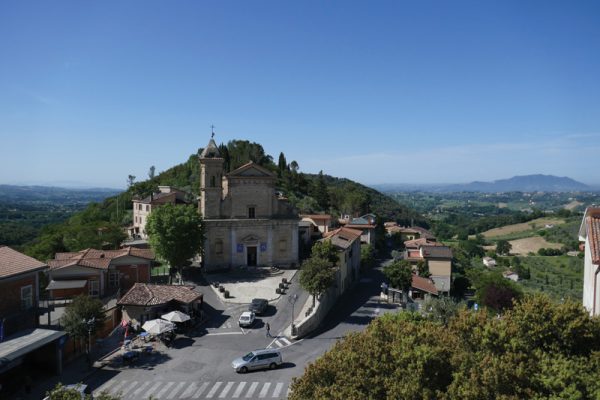
The most delightful thing about this walking itinerary was that I found myself regularly looking up to the pretty hilltop villages of the region.
Originally built for defensive reasons, these buildings are like the icing on cupcakes: honey-coloured medieval houses which spiral up to the peak and drizzle down the slopes like melting ice-cream.
One particular town caught my eye, because it stood out to be in perfect condition as if it were still in the 9th century. Also because I had a hard climb up the steep slopes at the end of the day to reach its town centre, where I was to stay for the night.
Labro, nicknamed the ‘stone village’, is an ancient fortress-commune guarding the border of Umbrian and Rieti lands.
Part of the reason it is so perfect is that the town suffered depopulation after the Second World War. In an attempt to lure people back, in 1968 the heirs of the old noble family invested money to fully restore every single building in the town to promote tourism.
A couple of days later, I stayed in a restored 15th-century palazzetto in another hilltop village, Casperia, which is known for its olive oil.
Like a sunning cat, I perched high above the town walls at Piazza Umberto I to admire the sunset as it washed the Rieti Valley in the last of the golden lights of the day.
Then the bells of Chiesa della Santissima Annunziata announced that it was time for a meal and to rest my feet for the next day.
Setting off Early
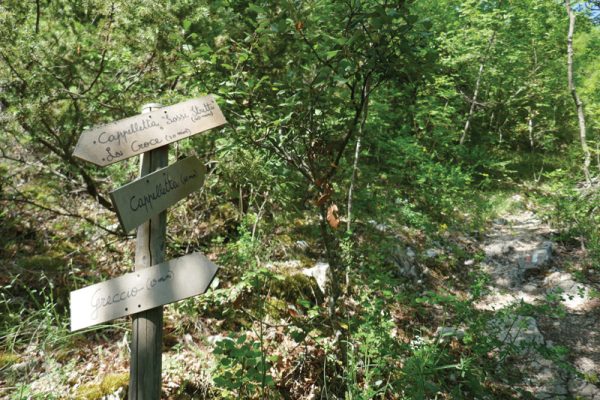
Every day, I wake up in a different village or a farm to greetings of the friendly proprietors and fellow travellers.
I try to set off early in the morning, to give myself plenty of time to complete the day’s mileage while also allowing myself some buffer time to get lost a little.
Once I leave a town, I find myself among the diverse landscapes of Umbria: dense pine forests, meadows on the valley floor, calm-flowing rivers and farms.
Natural springs flow through the region, bursting with clear, fresh water at various points and gathering into cooling pools where I enjoy a quick dip in nature. Where fountains have been installed I am also able to refill my water bottle.
There are mountains too – perhaps not as grand as the Dolomites in the north but still impressive; their outlines gleam in the sun against the blue sky.
I walk slowly, observing each and every shape and colour of nature, occasionally stopping at the sounds of wildlife being disturbed by my stomping.
A bird might ruffle its feathers, a lizard slinks out of sight. A slow worm, not to be mistaken for a snake, rolled itself ever so leisurely under the foliage, and a family of wild boars with ten young piglets dashed across my path in a patch of oak forest, where I rooted my feet to the ground, feeling both excited and terrified as I waited for them to disappear out of sight.
The route guides provided by On Foot Holidays threaded me through this wild, untouched nature, what many would truly call off-the-beaten-path. It also allowed me to feel perhaps how St Francis might have felt when he spent his time among the same nature in Umbria.
In the Name of Saint Francis
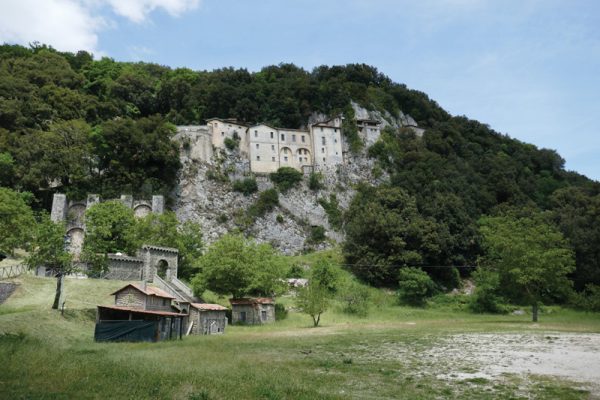
I noticed the little seashells that indicate that I am on both the Via di San Francesco and Via Francigena, official pilgrimages linked to the Camino de Santiago.
In these parts of Italy, the route is dominated by the worship of one particular saint: the local Umbrian, St Francis of Assisi.
Saint Francis is the patron saint of animals and the environment. He advocated love for and protection of nature, and is believed to have been able to communicate with animals and perform miracles for them as well as for people.
Religious beliefs aside, I found it thought-provoking that I was following his way during this time of climate change.
From day one to day six of my itinerary, the presence of St Francis was never too far away, both through the nature that I experienced on the walk and also in the churches and chapels where he is worshiped.
But it was in Greccio, on my third day, where I felt his presence most strongly, for it was here that he settled for a while, establishing the Hermitage of Greccio Sanctuary on the rock face of a cliff, of what is known as the Sacred Valley among the Sabine Hills.
It was while he was in Greccio that St Francis is believed to have invented the Christmas nativity scene.
Beyond the town’s Nativity Museum, Greccio also has small nativity displays dotted about its streets, and St Francis is featured in many of the murals of the town’s art trail.
Travel in the Slow Lane
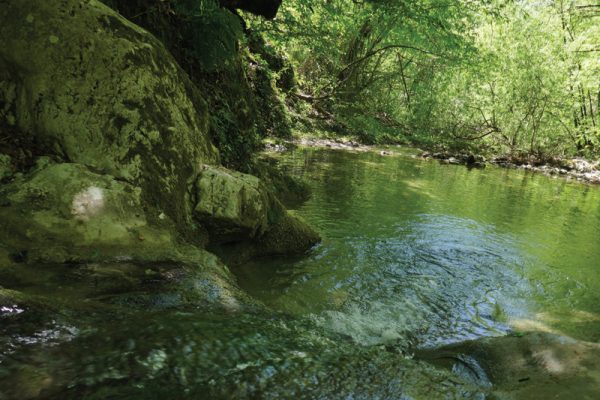
There is a lot to see in Umbria and, no matter how slowly I travel through the region, I am bound to miss something or other, and to forget the things I have seen because sometimes I am so focused on ticking check lists. But it has to be said that Umbria is well set up for a walking holiday.
And it is with this thought that I ended my walk in the lovely agriturismo Le Mole sul Farfa near Mompeo, where I really started to feel six days of exercise in my legs and decided to spend the rest of the afternoon not sightseeing, but letting myself sit by the pool, surrounded by the green hills I’ve just come out of.
I didn’t come here seeking a religious connection. I did, however, find a great way to see Umbria.
Walking made the journey across the landscape much more meaningful and fulfilling. And the experience was made even better by knowing that my luggage was being transferred every day to my next lodgings, so I could truly relax and enjoy myself without having to carry everything with me!
For more travel blogs, visit our travel archive
All images © Amy McPherson
